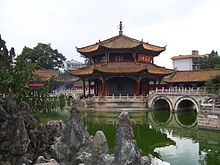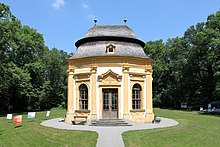pavilion

The pavilion is either a free-standing, lightweight structure in a garden or park, a protruding part of a structure that stands out from the rest of the building through a roof that is usually designed as a dome , or a smaller new building assigned to a main building (e.g. in Schools or hospitals). In addition, buildings for trade fairs and exhibitions are also referred to as pavilions, regardless of their construction. Until the 18th century the term “pavilion” stood for a large, square (war) tent; it is borrowed from French and ultimately comes from the Latin word “papilio”, which actually means “butterfly”, but already stands for a tent in late Latin . The transmission is said to come from the fact that the folded ends at the tent exit reminded of the appearance of a butterfly.
Detached building
A free-standing pavilion (also known as a Salettl ) is a roofed structure that is usually open all around or that can be opened. The floor plan is often circular or approximating to the shape of a circle, i.e. H. Pavilions often have the shape of a regular polygon , an ellipse, a rectangle whose side lengths differ little from each other, or some other form of central building . The floor plan is often point-symmetrical . This property is often emphasized by hipped , conical, dome or pyramid roofs or by surrounding cornices.
The pavilion has a long tradition in Asia , especially in Chinese architecture . The shape of the pavilion can also be found in Japan , India and Thailand , often in sacred buildings. In Buddhist temples, the pavilion is used in a variety of ways. Especially in Thailand it is very popular in the form of the sala in and outside of temples.
Although already known and used in antiquity , the pavilion appears more and more in European architecture in the Baroque era in the parks and gardens of the nobility, as an outbuilding of a castle, as a resting place, vantage point or simply as a design element. It later spread to the gardens of the wealthy bourgeoisie and was used there for the same purposes. The music pavilions in spa facilities should be mentioned in public buildings. In modern architecture , some sports arenas show features of the pavilion. Around 1900 the pavilion system or the pavilion style was a concept of hospital construction, from which one promised advantages also by being embedded in park-like facilities. Outbuildings of schools that house classrooms are also called pavilions, such as those at the Philipp Reis School .
Pavilion as part of a larger building
In baroque secular building , especially in French-style castle construction, a structure clearly emphasized within a multi-part building with its own roof is called a pavilion. It was used to structure the facade of a larger building, to visually distinguish the corps de logis from the side wings or to close off the side wings with a vertical accent.
Modern architecture also uses this style element in a variety of ways, for example in the new Federal Chancellery in Berlin.
Baroque Belvedere Palace in Vienna with its corner pavilions
Houghton Hall country house in Norfolk with two corner pavilions
Garden pavilion

The modern garden pavilion also comes close to the definition of a free-standing, lightweight structure in a garden. There are basically two types of garden pavilions: like a garden house made of wood or stone firmly anchored in the ground, or garden pavilions made of metal that can be easily assembled and dismantled. Mobile garden pavilions consist of a frame made of metal, which is covered with a covering made of textiles or robust plastics. The side walls can usually be opened and closed at will. They are also called party pavilions and are a form of party tents .
The two construction methods differ not only in the flexibility they offer - garden pavilions made of metal can be set up for festivities according to the wishes of the garden owner and then dismantled again, whereas permanently installed pavilions must remain in the chosen location. There are also differences in terms of building regulations: a foundation usually has to be poured for permanently installed pavilions. A shaft permit is required for this, depending on the municipal building regulations. A building permit may even be required for pavilions with brick walls, as they are classified as buildings. For the erection of a garden pavilion, the consent of the other parties must also be obtained for rental apartments or gardens that are accessible to all tenants.
Hunting pavilion
A hunting pavilion is a facility for accommodating several people. Furthermore, the hunting gear for the upcoming hunt was stored and made available here. Most of the hunting pavilions were built by aristocratic aristocrats between the 15th and 18th centuries near the actual hunting area. Back then, the nobility did not primarily hunt for food, but primarily for leisure purposes.
The interior of hunting pavilions consisted largely of wood and natural materials. In addition, the walls were often decorated with hunting paintings and hunting trophies such as B. adorned deer antlers. Often stables and utility buildings were used in the outdoor area to accommodate horses, carriages and entourage .
Well-known hunting pavilions
- Hunting pavilion (Eutin)
- Weilimdorf hunting pavilion
- Bärenschlössle hunting pavilion Stuttgart
- Hunting pavilion (Darmstadt)
- Hunting pavilion (Oberschleißheim)
See also
- German-Soviet Friendship Pavilion ( Stalin Pavilion ) in the GDR
- Sala (architecture) , pavilions in Thailand
- Pavilion style in 19th and early 20th century hospital buildings
- Pavilion school , reform-oriented school building style in the 20th century
literature
sorted alphabetically by author
- Ulrika Kiby: The pavilion on pillars. Art between tradition and religion. In: The garden art . 14 (1/2002), pp. 56-64.
- Francesca Prina: Atlas Architecture. History of architecture. DVA, Munich 2006, ISBN 3-421-03606-3 .
- Ernst Seidl: Lexicon of building types. Functions and forms of architecture. Reclam, Stuttgart 2006, ISBN 3-15-010572-2 .
Web links
Individual evidence
- ↑ Pevsner, Honor, Fleming: Lexikon der Weltarchitektur. Prestelverlag, Munich 1992.
- ^ Pavilion. In: Digital dictionary of the German language . Retrieved September 25, 2018





